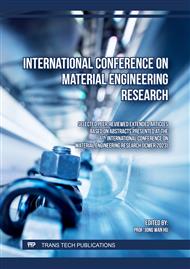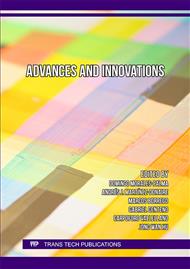[1]
P. Singh, J. P. Shakya, P. Agarwal, S. Jain, D. P. Mondal, and K. S. Verma, "Synthesis of Lightweight Metallic Foam and Their Applications in Various Engineering Sectors," Mater. Horizons From Nat. to Nanomater., p.51–74, 2023.
DOI: 10.1007/978-981-19-7146-4_3
Google Scholar
[2]
M. Madgule, C. G. Sreenivasa, and A. V. Borgaonkar, "Aluminium metal foam production methods, properties and applications- a review," Mater. Today Proc., no. xxxx, 2022.
DOI: 10.1016/j.matpr.2022.11.287
Google Scholar
[3]
H. K. Balakrishnan, E. H. Doeven, A. Merenda, L. F. Dumée, and R. M. Guijt, "3D printing for the integration of porous materials into miniaturised fluidic devices: A review," Anal. Chim. Acta, vol. 1185, 2021.
DOI: 10.1016/j.aca.2021.338796
Google Scholar
[4]
K. A. Mustapha et al., "Production of Open-Cell Foam Using Additive Manufacturing Method and Porous Morphology Effects," in Lecture Notes in Mechanical Engineering, 2022, p.13–16.
DOI: 10.1007/978-981-19-3179-6_3
Google Scholar
[5]
T. Wan, Y. Liu, C. Zhou, X. Chen, and Y. Li, "Fabrication, properties, and applications of open-cell aluminum foams: A review," J. Mater. Sci. Technol., vol. 62, p.11–24, 2021.
DOI: 10.1016/j.jmst.2020.05.039
Google Scholar
[6]
G. Zhang, B. Zou, X. Wang, Y. Yu, and Q. Chen, "Design, manufacturing and properties of controllable porosity of ceramic filters based on SLA-3D printing technology," Ceram. Int., vol. 49, no. 1, p.1009–1019, 2023.
DOI: 10.1016/j.ceramint.2022.09.076
Google Scholar
[7]
S. Whitaker, "The Forchheimer equation: A theoretical development," Transp. Porous Media, vol. 25, no. 1, p.27–61, 1996.
DOI: 10.1007/BF00141261
Google Scholar
[8]
P. Wang, M. Qi, C. Ma, and F. Zhu, "Experimental investigation of the pressure-drop characteristics of open-cell metal foam with air-gaps under non-Darcy flow regimes," Exp. Therm. Fluid Sci., vol. 140, no. March 2022, p.110736, 2023.
DOI: 10.1016/j.expthermflusci.2022.110736
Google Scholar
[9]
S. H. Park, D. H. Seo, and J. H. Jeong, "Experimental and numerical analysis of thermal flow in open-cell porous metal during Darcy-Forchheimer transition regime," Appl. Therm. Eng., vol. 181, no. September, p.116029, 2020.
DOI: 10.1016/j.applthermaleng.2020.116029
Google Scholar
[10]
M. Bracconi et al., "Investigation of pressure drop in 3D replicated open-cell foams: Coupling CFD with experimental data on additively manufactured foams," Chem. Eng. J., vol. 377, no. October 2018, p.120123, 2019.
DOI: 10.1016/j.cej.2018.10.060
Google Scholar
[11]
H. Lehmann, E. Werzner, A. Malik, M. Abendroth, S. Ray, and B. Jung, "Computer-Aided Design of Metal Melt Filters: Geometric Modifications of Open-Cell Foams, Effective Hydraulic Properties and Filtration Performance," Adv. Eng. Mater., vol. 24, no. 2, 2022.
DOI: 10.1002/adem.202100878
Google Scholar
[12]
N. Dukhan, Ö. Baǧci, and M. Özdemir, "Experimental flow in various porous media and reconciliation of Forchheimer and Ergun relations," Exp. Therm. Fluid Sci., vol. 57, p.425–433, 2014.
DOI: 10.1016/j.expthermflusci.2014.06.011
Google Scholar
[13]
H. Yang, Y. Li, B. Ma, and Y. Zhu, "Review and a theoretical approach on pressure drop correlations of flow through open-cell metal foam," Materials (Basel)., vol. 14, no. 12, 2021.
DOI: 10.3390/ma14123153
Google Scholar
[14]
A. Bhattacharya, V. V Calmidi, and R. L. Mahajan, "Thermophysical properties of high porosity metal foams," Int. J. Heat Mass Transf., vol. 45, p.1017–1031, 2002.
DOI: 10.1016/s0017-9310(01)00220-4
Google Scholar
[15]
A. Iranmanesh, S. A. Moshizi. Flow and Heat Transfer Study of an Annulus Partially Filled with Metallic Foam on Two Wall Surfaces Subject to Asymmetrical Heat Fluxes. Arab J Sci Eng (2023)
DOI: 10.1007/s13369-023-07895-6
Google Scholar



